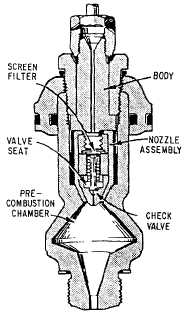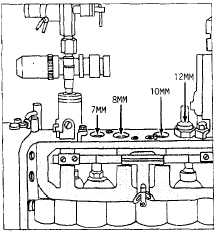delivery and the capsule type injector valve (fig, 5-6), which injects and atomizes the fuel.
The most likely causes of faulty fuel injection performance are (1) air in the fuel, (2) low fuel supply, (3) water in the fuel, (4) dirty fuel filters, and (5) low transfer pump pressure. If, after you have checked and corrected these conditions, the engine still does not perform properly, check the fuel injection components. Some of the guidelines for troubleshooting and general test procedures used to test pumps and valves are discussed below.
TROUBLESHOOTING. - Before you remove either the injector pump or injector valve from an erratically running engine, make a simple test. Run the engine at a speed that makes the defect most pronounced. Momentarily, loosen the fuel line nut on the injector pump far enough so that the cylinder misfires or cuts out. Check each cylinder in the same manner. If you find one that has no effect on the irregular operation of the engine or black smoke stops puffing from the exhaust, you have located the misfiring cylinder. You will probably only have to remove the pump and valve for that cylinder for additional testing.
TESTING. - The Caterpillar fuel injection tester provides a means for determining the condition of the fuel injection pumps and valves. Before you perform any test, be sure to study and follow the instructions in

Figure 5-6.-Capsule type of fuel injection valve assembly.
the manual for the type of testing equipment you are using.
Injection Pump. - Clean the fuel pump thoroughly before installing it on the tester. If any abrasive material enters the pump, it may be carried into the discharge collector of the tester and impair the discharge measurement accuracy. Close the fuel pump openings with the covers provided, holding the plunger in place. Clean the pump thoroughly with cleaning solvent or fuel oil.
Pumps are tested at or near (within .025 inch) the full-load setting of the engine. If the fuel delivery from the pump is within the limits of the full-load setting, the pump will perform properly throughout the full range of rack travel. The governor will compensate for pump wear at any rack setting less than the full-load setting.
Caterpillar fuel injection pumps have no adjustments or replacement parts for rebuilding. If the tester reveals that the pump is no longer serviceable, discard the pump.
To test the injector pump, determine the plunger diameter by inserting the portion of the plunger under the gear into the gauge supplied with the tester. Insert the portion of the pump plunger and gear segment into the gauge setting of the housing of the tester, as shown in figure 5-7. Determine the proper full-load rack setting by referring to the rack setting charts for the engine from which the pump was removed. After you have made the full-rack setting (usually to the nearest .025 inch), you also will be able to determine the number of discharge strokes required from the pump test chart. Now you are ready to attach the collector assembly and jar to the fuel

Figure 5-7.-Test location of various size pumps.
Continue Reading